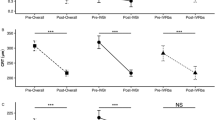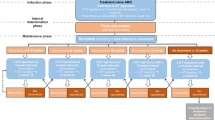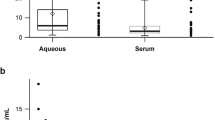Abstract
Background
Baseline OCT morphology of macular edema (ME) due to branch (BRVO) or central retinal vein occlusion (CRVO) was evaluated with respect to response to bevacizumab treatment.
Methods
Sixty-five patients (33 CRVO, 32 BRVO) were treated with intravitreal injections of 2.5 mg bevacizumab. Reinjections were only performed if ME persisted or recurred. Follow-up ranged from 23 to 128 weeks. OCT (Stratus OCT™, Carl Zeiss Meditec) morphology at baseline was analyzed retrospectively to evaluate its effect on treatment outcome (ETDRS visual acuity and central retinal thickness). Baseline OCT scans were studied with regard to central retinal thickness (CRT), presence and height of subretinal fluid (SRF), intraretinal cystoid spaces (ICS) and maximum horizontal diameter of the largest delimitable ICS.
Results
In CRVO patients, baseline CRT is not correlated with CRT at last visit, but there is a significant correlation of baseline CRT with final visual acuity (VA). Presence of SRF and diameter of ICS do not influence functional and morphological response to bevacizumab treatment.
Baseline CRT in BRVO patients is not significantly correlated with final VA and final CRT. There is no difference in treatment response between patients with or without baseline SRF. BRVO patients with large ICS >600 μm (13.8%) at baseline had a significantly worse VA at last visit than patients with smaller ICS (p = 0.011), and did not achieve a significant improvement under bevacizumab therapy. The duration of retinal vein occlusion before start of treatment was significantly longer in patients with ICS >600 μm (232 ± 96 weeks versus 17 ± 17 weeks; p < 0.001). There is no correlation of ICS diameter and duration of vein occlusion in patients with ICS <600 µm.
Conclusions
In CRVO patients, baseline CRT and final VA are significantly correlated, whereas the presence of SRF or diameter of ICS was not predictive for treatment outcome. In BRVO patients, ICS with a diameter of >600 μm are associated with a long duration of vein occlusion and poor functional response to treatment with bevacizumab. CRT and SRF were not found to be significant prognostic factors.



Similar content being viewed by others
References
Kriechbaum K, Michels S, Prager F, Georgopoulos M, Funk M, Geitzenauer W, Schmidt-Erfurth U (2008) Intravitreal Avastin for macular oedema secondary to retinal vein occlusion: a prospective study. Br J Ophthalmol 92:518–522
Ota M, Tsujikawa A, Murakami T, Yamaike N, Sakamoto A, Kotera Y, Miyamoto K, Kita M, Yoshimura N (2008) Foveal photoreceptor layer in eyes with persistent cystoid macular edema associated with branch retinal vein occlusion. Am J Ophthalmol 145:273–280
Sasahara M, Mikawa A, Tajiri K, Kojima H, Saito I (2006) Visual prognosis of branch retinal vein occlusion with macular edema. Nippon Ganka Gakkai Zasshi 110:293–299
The Central Vein Occlusion Study Group (1997) Natural history and clinical management of central retinal vein occlusion. Arch Ophthalmol 115:486–491
Zhang H, Xia Y (2002) Analysis of visual prognosis and correlative factors in retinal vein occlusion. Zhonghua Yan Ke Za Zhi 38:98–102
Hoeh AE, Ach T, Schaal KB, Scheuerle AF, Dithmar S (2009) Long-term follow-up of OCT-guided bevacizumab treatment of macular edema due to retinal vein occlusion. Graefes Arch Clin Exp Ophthalmol 247:1635–1641
Kondo M, Kondo N, Ito Y, Kachi S, Kikuchi M, Yasuma TR, Ota I, Miyake K, Terasaki H (2009) Intravitreal injection of bevacizumab for macular edema secondary to branch retinal vein occlusion: Results after 12 months and multiple regression analysis. Retina 29:1242–1248
Chung EJ, Hong YT, Lee SC, Kwon OW, Koh HJ (2008) Prognostic factors for visual outcome after intravitreal bevacizumab for macular edema due to branch retinal vein occlusion. Graefes Arch Clin Exp Ophthalmol 246:1241–1247
Spaide RF, Chang LK, Klancnik JM, Yannuzzi LA, Sorenson J, Slakter JS, Freund KB, Klein R (2009) Prospective study of intravitreal ranibizumab as a treatment for decreased visual acuity secondary to central retinal vein occlusion. Am J Ophthalmol 147:298–306
Yamaike N, Tsujikawa A, Ota M, Sakamoto A, Kotera Y, Kita M, Miyamoto K, Yoshimura N, Hangai M (2008) Three-dimensional imaging of cystoid macular edema in retinal vein occlusion. Ophthalmology 115:355–362
Catier A, Tadayoni R, Paques M, Erginay A, Haouchine B, Gaudric A, Massin P (2005) Characterization of macular edema from various etiologies by optical coherence tomography. Am J Ophthalmol 140:200–206
Ota M, Tsujikawa A, Kita M, Miyamoto K, Sakamoto A, Yamaike N, Kotera Y, Yoshimura N (2008) Integrity of foveal photoreceptor layer in central retinal vein occlusion. Retina 28:1502–1508
Spaide RF, Lee JK, Klancnik JK Jr, Gross NE (2003) Optical coherence tomography of branch retinal vein occlusion. Retina 23:343–347
Marmor MF (1999) Mechanisms of fluid accumulation in retinal edema. Doc Ophthalmol 97:239–249
Park SP, Ahn JK, Mun GH (2010) Aqueous vascular endothelial growth factor levels are associated with serous macular detachment secondary to branch retinal vein occlusion. Retina 30(2):281–286, doi:10.1097/IAE.0b013e3181b9f153
Yamaguchi Y, Otani T, Kishi S (2006) Serous macular detachment in branch retinal vein occlusion. Retina 26:1029–1033
Scott IU, Vanveldhuisen PC, Oden NL, Ip MS, Blodi BA, Jumper JM, Figueroa M (2009) SCORE Study report 1: baseline associations between central retinal thickness and visual acuity in patients with retinal vein occlusion. Ophthalmology 116:504–512
Yanoff M, Fine BS, Brucker AJ, Eagle RC Jr (1984) Pathology of human cystoid macular edema. Surv Ophthalmol 28(Suppl):505–511
Fine BS, Brucker AJ (1981) Macular edema and cystoid macular edema. Am J Ophthalmol 92:466–481
Tso MO (1982) Pathology of cystoid macular edema. Ophthalmology 89:902–915
Author information
Authors and Affiliations
Corresponding author
Additional information
Financial relationship: No author has any financial interest in the manuscript.
Rights and permissions
About this article
Cite this article
Hoeh, A.E., Ruppenstein, M., Ach, T. et al. OCT patterns of macular edema and response to bevacizumab therapy in retinal vein occlusion. Graefes Arch Clin Exp Ophthalmol 248, 1567–1572 (2010). https://doi.org/10.1007/s00417-010-1419-5
Received:
Revised:
Accepted:
Published:
Issue Date:
DOI: https://doi.org/10.1007/s00417-010-1419-5




